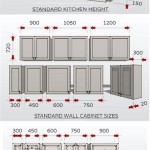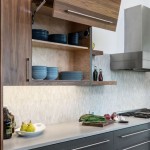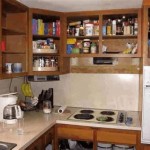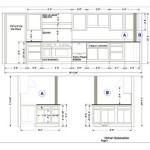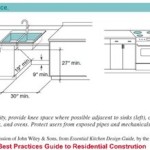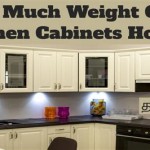Kitchen Cabinets: Optimizing Wall Space for Functionality and Aesthetics
Kitchen cabinets constitute a cornerstone of kitchen design, impacting both functionality and aesthetics. The proper selection and configuration of wall cabinets, in particular, are crucial for maximizing storage, improving workflow, and establishing the overall visual appeal of the space. Wall cabinets, mounted directly onto the walls, offer several distinct advantages over base cabinets and freestanding storage solutions, including enhanced accessibility, efficient space utilization, and the opportunity to create a visually cohesive design scheme.
This article delves into the critical aspects of kitchen wall cabinets, exploring their various types, materials, design considerations, and installation practices. A comprehensive understanding of these elements empowers homeowners and designers to make informed decisions and optimize their kitchen spaces for both practicality and beauty. The focus will remain on factual information and objective analysis, providing a resource for those seeking to enhance their kitchen through thoughtful cabinet selection and placement.
Key Considerations for Selecting Kitchen Wall Cabinets
Before embarking on the selection process, several key factors must be considered to ensure the chosen wall cabinets meet the specific needs of the kitchen. These considerations encompass spatial constraints, storage requirements, aesthetic preferences, and budgetary limitations. A thorough assessment of these elements will guide the selection process and contribute to a successful outcome.
Firstly, the available wall space must be accurately measured. This includes determining the total wall length, the height from the countertop to the ceiling, and the locations of any obstructions, such as windows, doors, or plumbing fixtures. Accurate measurements are essential for determining the maximum size and configuration of the wall cabinets. Furthermore, understanding the spatial limitations will facilitate the selection of appropriate cabinet styles and sizes that integrate seamlessly into the existing layout.
Secondly, an evaluation of storage requirements is crucial. Determining the types and quantities of items to be stored in the wall cabinets will inform the selection of cabinet depth, shelving configurations, and specialized storage solutions. For example, if storing large platters or bulky appliances is a priority, deeper cabinets with adjustable shelves may be necessary. Conversely, if storing smaller items, such as spices or glassware, shallower cabinets with multiple shelves or pull-out organizers may be more appropriate. Thoughtful consideration of storage needs will maximize the functionality of the wall cabinets and minimize clutter on countertops.
Thirdly, aesthetic preferences play a significant role in the selection process. Wall cabinets contribute substantially to the overall visual appeal of the kitchen, and their style, finish, and hardware should complement the existing decor. A wide range of styles is available, from traditional raised-panel cabinets to modern sleek cabinets with minimalist hardware. Selecting a style that aligns with the homeowner’s personal taste and the overall design scheme of the kitchen is essential for creating a cohesive and visually pleasing space. The finish of the cabinets, whether painted, stained, or laminated, also contributes to the aesthetic impact and should be chosen to complement the flooring, countertops, and backsplash.
Finally, budgetary limitations must be taken into account. Kitchen wall cabinets are available in a wide range of price points, depending on the materials, construction quality, and features. Establishing a budget upfront will help narrow down the selection and prevent overspending. Exploring different material options, such as particleboard, MDF, or solid wood, can help balance cost and quality. Additionally, considering prefabricated or ready-to-assemble (RTA) cabinets can provide a more affordable alternative to custom-built cabinets.
Types of Kitchen Wall Cabinets
Kitchen wall cabinets are available in a variety of types, each designed to serve specific purposes and meet different storage needs. Understanding the different types of wall cabinets allows for strategic planning and optimal space utilization. The primary types include standard cabinets, specialty cabinets, and open shelving.
Standard wall cabinets are the most common type and are typically rectangular in shape. They are available in a range of heights and depths to accommodate various storage requirements. Standard cabinets are versatile and can be used for storing a wide variety of items, from dishes and glassware to pantry staples and small appliances. They are typically fitted with adjustable shelves, allowing for customization of the interior space to accommodate different item sizes.
Specialty wall cabinets are designed for specific purposes or to fit into unconventional spaces. Examples include corner cabinets, which are designed to maximize storage in corner areas; over-the-range cabinets, which are designed to house a range hood; and wine racks, which are designed to store wine bottles. These specialty cabinets can significantly enhance the functionality and organization of the kitchen. Corner cabinets, in particular, can be challenging to design, but specialized options like lazy susans or pull-out shelves can greatly improve accessibility and storage capacity. Over-the-range cabinets not only conceal the range hood but also provide additional storage space above the cooktop. Wine racks can add a touch of elegance to the kitchen while providing a convenient and organized storage solution for wine enthusiasts.
Open shelving offers a more open and airy alternative to traditional wall cabinets. Open shelves can be used to display decorative items, store frequently used items within easy reach, or create a more informal and inviting atmosphere. While open shelving can be visually appealing, it is important to consider the potential for dust and clutter. Regular cleaning and careful arrangement of items are necessary to maintain a tidy and organized appearance. Open shelving can be particularly effective when used in conjunction with traditional cabinets to create a balanced and visually interesting design.
Beyond these fundamental types, variations exist in door styles (e.g., shaker, flat-panel, raised-panel), construction methods (e.g., framed, frameless), and internal organization features (e.g., pull-out drawers, spice racks). Evaluating these nuances ensures the selected cabinets align perfectly with the desired aesthetic and functional requirements.
Materials and Construction of Wall Cabinets
The materials used in the construction of kitchen wall cabinets significantly impact their durability, appearance, and cost. Understanding the characteristics of different materials is essential for making informed decisions that balance budget constraints with desired quality and aesthetics. Common materials used for wall cabinets include solid wood, plywood, particleboard, and medium-density fiberboard (MDF).
Solid wood is a premium material known for its durability, beauty, and timeless appeal. Solid wood cabinets are typically made from hardwoods such as maple, oak, cherry, or walnut. Solid wood is resistant to dents and scratches and can be refinished multiple times, making it a long-lasting investment. However, solid wood is also the most expensive material option and is susceptible to warping or cracking in humid environments if not properly sealed and maintained. The natural grain patterns and variations in color add character and warmth to the kitchen.
Plywood is an engineered wood product made from layers of wood veneer glued together. Plywood is stronger and more stable than solid wood, making it a good choice for cabinet boxes and shelving. Plywood is less susceptible to warping or cracking than solid wood and is more affordable. High-quality plywood with a smooth surface is often used for painting or staining. The layered construction of plywood provides excellent strength and resistance to moisture, making it a durable and reliable material for kitchen cabinets.
Particleboard is an engineered wood product made from wood chips and resin pressed together. Particleboard is the most affordable material option but is also the least durable. Particleboard is susceptible to water damage and can swell or crumble if exposed to moisture. Particleboard is typically used for cabinet boxes and shelving in lower-cost cabinets. While particleboard is less expensive, it is important to note its limitations in terms of durability and moisture resistance. Cabinets made with particleboard may not last as long as those made with solid wood or plywood.
Medium-density fiberboard (MDF) is an engineered wood product made from wood fibers and resin pressed together. MDF is denser and more stable than particleboard and provides a smooth surface for painting or laminating. MDF is less susceptible to warping or cracking than solid wood and is a good choice for cabinet doors and drawer fronts. MDF is also relatively affordable and is a popular choice for modern and contemporary kitchen designs. The smooth surface of MDF allows for clean lines and crisp edges, making it ideal for painted finishes.
The construction method of wall cabinets also plays a significant role in their durability and stability. Framed cabinets have a face frame that is attached to the cabinet box, providing added strength and stability. Frameless cabinets, also known as European-style cabinets, do not have a face frame, providing more interior storage space and a sleeker, more modern look. The choice between framed and frameless cabinets depends on personal preference and the desired aesthetic of the kitchen. Framed cabinets are generally more traditional in appearance, while frameless cabinets are more contemporary.
Ultimately, the optimal selection of materials and construction techniques depends on a careful balancing of budget, style preferences, and anticipated usage. By understanding the pros and cons of each option, homeowners can make informed decisions that result in durable, aesthetically pleasing, and functional kitchen wall cabinets.

Wall Units Kitchen Diy Kitchens

Kitchen Wall Cabinets Design Concepts

Most Popular Types Of Kitchen Wall Cabinets Designcafe

5 Smart Wall Storage Ideas To Upgrade Your Kitchen

The Top 10 Kitchen Wall Cabinet Options Vestabul School Of Design

Tall Kitchen Pantry Cabinets Create A Full Wall Effect Sweeten

How To Organise Your Kitchen Wall Cabinets More Efficiently

Oppein Kitchen In Simple Brown Acrylic Single Wall Cabinet Plcc20247

Cabinet Types Base Wall And Pantry Cabinets Cliqstudios

Kitchen Wall Cabinets Pictures Options Tips Ideas
Related Posts

